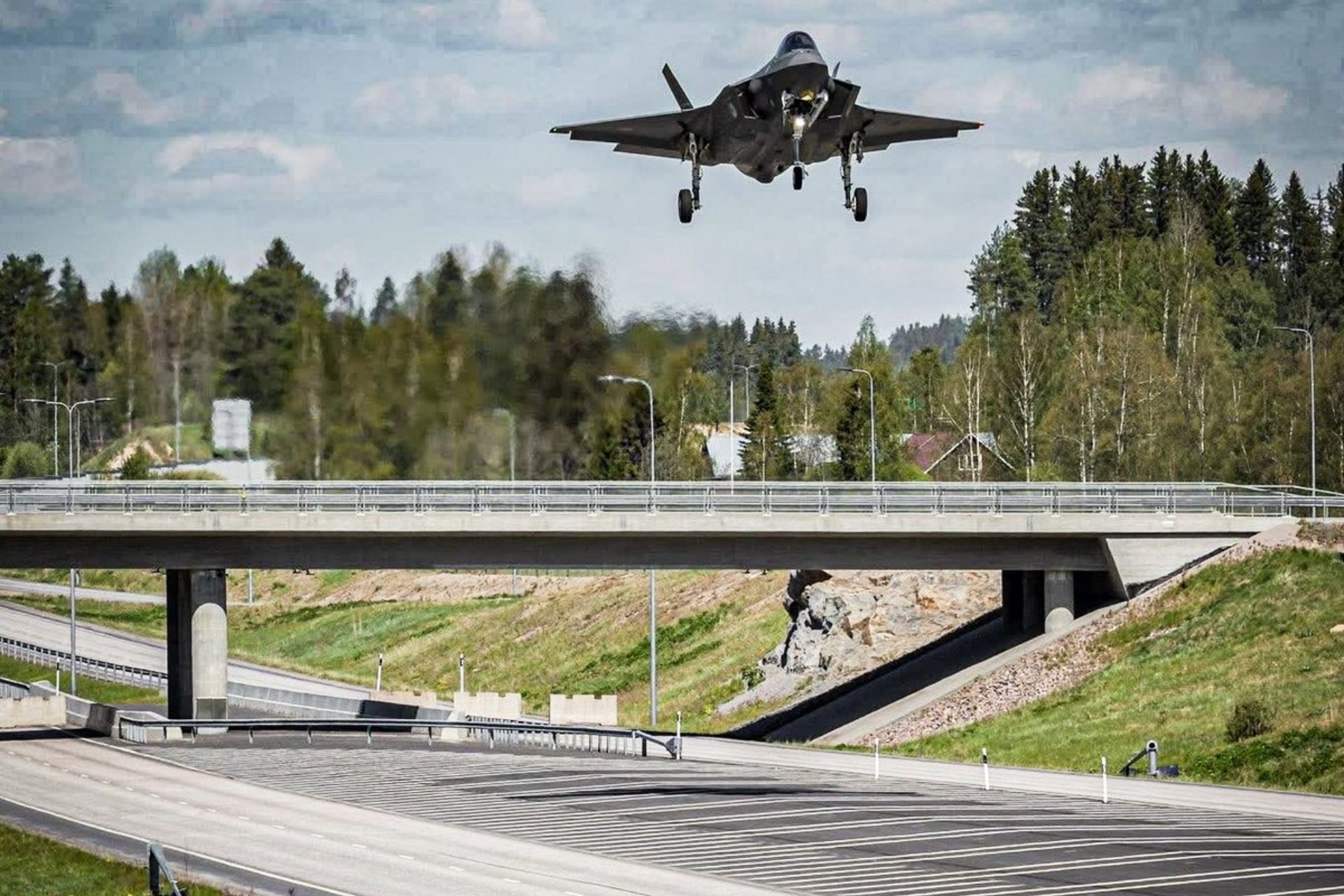Dutch F-35A Fighter Jets Land on Finnish Highway During Dispersed Warfare Exercise

{loadposition bannertop}
{loadposition sidebarpub}
From May 26 to 29, 2025, Finland hosted Exercise Baana 25, a major military training exercise conducted by the Ilmavoimat, focusing on dispersed air operations. For the first time, the Royal Netherlands Air Force took part with its F-35A Lightning II fighter jets. These fifth-generation aircraft operated alongside Finnish F/A-18C/D Hornets, Hawk Mk.51 and Mk.66 trainers, and a Learjet 35. Flights were carried out on a specially adapted section of National Road 4 near Tikkakoski, temporarily converted into a makeshift runway for the exercise.Follow Army Recognition on Google News at this link
Dutch F-35As from Pirkkala Air Base conducted touch-and-go maneuvers under Finnish and NATO observation (Picture source: NATO)
For the Dutch pilots, Baana 25 was an opportunity to practice takeoff and landing procedures on civilian roads, following the principles of Agile Combat Employment (ACE). This concept, derived from the U.S. military’s Dynamic Force Employment strategy, is intended to enable air forces to operate from austere and minimally equipped sites. It aims to maintain operational effectiveness while increasing survivability in the face of threats such as ballistic missiles, drones, or saturation strikes. By multiplying potential deployment locations, even temporary or improvised, air forces seek to complicate adversary targeting and ensure continuity of operations.
The F-35A Lightning II is particularly suited to these types of missions. Developed by Lockheed Martin for the U.S. Air Force, the aircraft combines low observability, networked systems, and multirole capability. Powered by a Pratt & Whitney F135-PW-100 engine, the F-35A reaches speeds of Mach 1.6 and has a combat range of over 2,200 kilometers. It is armed with a 20 mm internal cannon, air-to-air missiles (AIM-120 AMRAAM, AIM-9X Sidewinder), precision-guided bombs (JDAM, SDB), and anti-radiation missiles (AGM-88 HARM). The aircraft is also equipped with advanced sensors, including the AN/APG-81 AESA radar, a Distributed Aperture System (DAS), an Electro-Optical Targeting System (EOTS), and an integrated electronic warfare suite. The pilot interface is built around a Helmet-Mounted Display System (HMDS) and fully digital avionics, enabling coordinated operations even in contested environments.
The Dutch aircraft were deployed from Pirkkala Air Base, located about 180 kilometers southwest of the highway landing site. From there, the F-35As conducted touch-and-go maneuvers, approaches followed by immediate takeoff without full stops, in the presence of Finnish military observers and NATO representatives. Photos released by the Finnish Air Force showed F/A-18s using arrestor hooks to stop after landing. Even the Learjet 35, typically used for command transport, was involved, reflecting the need for all types of aircraft to operate beyond conventional airbases.
Finland has long incorporated such scenarios into its national defense planning. The Baana exercise, known within NATO as “Imminent Field,” is held annually. In 2024, U.S. Air Force F-35As from the 495th Fighter Squadron landed on the Hosio highway strip in Ranua, the first recorded instance of a U.S. fighter jet operating from a Finnish road. In 2023, Royal Norwegian Air Force F-35s also participated. The involvement of the Netherlands in 2025 marks a further expansion of ACE implementation within Europe.
The military use of highways, developed during the Cold War, has regained relevance due to the war in Ukraine. Russian strikes on airbases located far from the front lines have underscored the necessity of dispersion for air assets. Several European nations have now incorporated road operations into their training schedules. In Switzerland, the 2024 Alpha One exercise saw F/A-18s operate on the A1 motorway. France’s Pégase 25 involved the rapid deployment of Rafale jets across multiple European locations. The United Kingdom and Italy recently trained in hot refueling of their Typhoons from forward locations in Italy.
In Finland, where the proximity to the Russian border remains a strategic consideration, partial militarization of road infrastructure is an established practice. Baana exercises are regularly open to the public, reflecting a broader effort to engage the civilian population. On May 29, hundreds of spectators gathered along the highway to observe the operations. For the Royal Netherlands Air Force, this was a chance to assess the F-35A’s ability to operate from improvised runways and to observe Finnish procedures ahead of Finland’s own F-35A integration.
Exercise Baana 25 reflects a broader trend among European air forces to adjust their posture in response to emerging operational challenges. As traditional airbases become more vulnerable, alternative deployment options such as roads and secondary airfields are gaining traction. Through combined exercises, interoperability, and operational experimentation, these drills illustrate the gradual shift in European air doctrines, particularly on NATO’s northeastern flank.

{loadposition bannertop}
{loadposition sidebarpub}
From May 26 to 29, 2025, Finland hosted Exercise Baana 25, a major military training exercise conducted by the Ilmavoimat, focusing on dispersed air operations. For the first time, the Royal Netherlands Air Force took part with its F-35A Lightning II fighter jets. These fifth-generation aircraft operated alongside Finnish F/A-18C/D Hornets, Hawk Mk.51 and Mk.66 trainers, and a Learjet 35. Flights were carried out on a specially adapted section of National Road 4 near Tikkakoski, temporarily converted into a makeshift runway for the exercise.
Follow Army Recognition on Google News at this link
Dutch F-35As from Pirkkala Air Base conducted touch-and-go maneuvers under Finnish and NATO observation (Picture source: NATO)
For the Dutch pilots, Baana 25 was an opportunity to practice takeoff and landing procedures on civilian roads, following the principles of Agile Combat Employment (ACE). This concept, derived from the U.S. military’s Dynamic Force Employment strategy, is intended to enable air forces to operate from austere and minimally equipped sites. It aims to maintain operational effectiveness while increasing survivability in the face of threats such as ballistic missiles, drones, or saturation strikes. By multiplying potential deployment locations, even temporary or improvised, air forces seek to complicate adversary targeting and ensure continuity of operations.
The F-35A Lightning II is particularly suited to these types of missions. Developed by Lockheed Martin for the U.S. Air Force, the aircraft combines low observability, networked systems, and multirole capability. Powered by a Pratt & Whitney F135-PW-100 engine, the F-35A reaches speeds of Mach 1.6 and has a combat range of over 2,200 kilometers. It is armed with a 20 mm internal cannon, air-to-air missiles (AIM-120 AMRAAM, AIM-9X Sidewinder), precision-guided bombs (JDAM, SDB), and anti-radiation missiles (AGM-88 HARM). The aircraft is also equipped with advanced sensors, including the AN/APG-81 AESA radar, a Distributed Aperture System (DAS), an Electro-Optical Targeting System (EOTS), and an integrated electronic warfare suite. The pilot interface is built around a Helmet-Mounted Display System (HMDS) and fully digital avionics, enabling coordinated operations even in contested environments.
The Dutch aircraft were deployed from Pirkkala Air Base, located about 180 kilometers southwest of the highway landing site. From there, the F-35As conducted touch-and-go maneuvers, approaches followed by immediate takeoff without full stops, in the presence of Finnish military observers and NATO representatives. Photos released by the Finnish Air Force showed F/A-18s using arrestor hooks to stop after landing. Even the Learjet 35, typically used for command transport, was involved, reflecting the need for all types of aircraft to operate beyond conventional airbases.
Finland has long incorporated such scenarios into its national defense planning. The Baana exercise, known within NATO as “Imminent Field,” is held annually. In 2024, U.S. Air Force F-35As from the 495th Fighter Squadron landed on the Hosio highway strip in Ranua, the first recorded instance of a U.S. fighter jet operating from a Finnish road. In 2023, Royal Norwegian Air Force F-35s also participated. The involvement of the Netherlands in 2025 marks a further expansion of ACE implementation within Europe.
The military use of highways, developed during the Cold War, has regained relevance due to the war in Ukraine. Russian strikes on airbases located far from the front lines have underscored the necessity of dispersion for air assets. Several European nations have now incorporated road operations into their training schedules. In Switzerland, the 2024 Alpha One exercise saw F/A-18s operate on the A1 motorway. France’s Pégase 25 involved the rapid deployment of Rafale jets across multiple European locations. The United Kingdom and Italy recently trained in hot refueling of their Typhoons from forward locations in Italy.
In Finland, where the proximity to the Russian border remains a strategic consideration, partial militarization of road infrastructure is an established practice. Baana exercises are regularly open to the public, reflecting a broader effort to engage the civilian population. On May 29, hundreds of spectators gathered along the highway to observe the operations. For the Royal Netherlands Air Force, this was a chance to assess the F-35A’s ability to operate from improvised runways and to observe Finnish procedures ahead of Finland’s own F-35A integration.
Exercise Baana 25 reflects a broader trend among European air forces to adjust their posture in response to emerging operational challenges. As traditional airbases become more vulnerable, alternative deployment options such as roads and secondary airfields are gaining traction. Through combined exercises, interoperability, and operational experimentation, these drills illustrate the gradual shift in European air doctrines, particularly on NATO’s northeastern flank.





